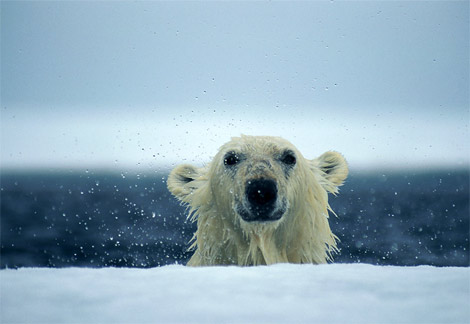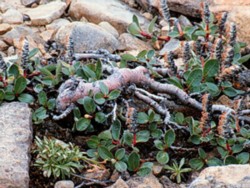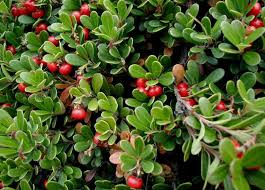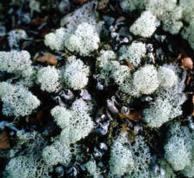Tundra Group J
Tundra

Tundra basics:
Tundra means treeless plain. The tundra is the coldest of all biomes and is known for extremely low temperatures, little precipitation, poor nutrients and short growing seasons due to lack of nutrients and the layer of permafrost (frozen layer of soil) prevents plants from growing deep roots. Two major nutrients found in this biome are nitrogen and phosperus.
Characteristic:
- Extremely cold climate
- Low biotic diversity
- Simple vegitation
- Short seasons of growth and reproduction
- Energy gathered from dead organic material
- Large population oscillations
The Tundra is seperated by two specified types Arctic Tundra and the Alpine Tundra.
The Arctic Tundra:
This Tundra is located in the northern hemispher and has a cold desert-like enviroment. The growing season ranges from only 50 to 60 days with winter temperature of -30 degrees F and an average summer temperature of 37-54 degrees F. Yearly precipitation, including melting snow, is 15 to 25 cm. Soil forms slowly and contains a frozen subsoil called permafrost, plants have no deep root systems, but are well adapted to the cold climate.
The Alpine Tundra:
This Tundra is located on ,ountains through out the world with elevations so high trees can not sustain life. The growing season is about 180 days and unlike the artic tundra the soil is well drained. Nighttime temps. of this tundra are usually below freezing.
Click here to view tundra's average monthly temp.
Click here to view tundra's average monthly precipitation
Enviromental Threats of the Tundra (enviromental profile):
The tundra's biggest threat is from oil and gas development and the resulting global warming. As the planet warms ( a result of burning fossil fuel), permafrost, a frozen layer of soil, begins to melt causing the Tundra's ecosystem to collapse. When the permafrost melts it contains dead plants within the soil (these plants were formed when the enviroment was much warmer and able to sustain plant life); as the permafrost melts the dead plants begin to decay and release CO2 which accelerates global warming even more so greatly effecting and distroying the tundra's enviroment.
Other Threats:
- The melting of permafrost as a result of global warming could radically change the landscape and what species are able to live there.
- Ozone depletion at the North and South Poles means stronger ultraviolet rays that will harm the tundra.
- Air pollution can cause smog clouds that contaminate lichen, a significant food source for many animals.
- Exploration of oil, gas and minerals and construction of pipelines and roads can cause physical disturbances and habitat fragmentation.
- Oil spills can kill wildlife and significantly damage tundra ecosystems.
- Buildings and roads put pressure on permafrost, causing it to melt.
- Invasive species push aside native vegitation and reduce diversity of plant cover.
Efforts to Reduce Enviromental Threats:
- Switch to alternative energy uses to minimize human-made global warming.
- Establish protected areas and park reserves to restrict human influence.
- Limit road construction, mining activities, and building of pipelines in tundra habitat.
- Limit tourism and respect local cultures.
Organizations With More Information on these Enviromental Threats:
- Artctic National Wildlife Refuge (ANWR)
101 12th Avenue, Room 236
Fairbanks, AK 99701
(800) 362-4546
Web site: http://arctiv.fws.gov
-
Environmental Defense Fund (EDF)
257 Park Avenue South
New York, NY 10010
(800) 684-3322
Web site: http://www.edf.org
-
Environmental Literacy Council
1625 Street NW, Suite 100
Washington, DC 20006-3868
(202) 296-0390
Web site: http://www.enviroliteracy.org
Symbiotic Relationships:
Mutualism:
- Lichens are an example of a mutualism symbiotic relationship. This is because the lichen combines with an alga and a fungus in order to be able to act as a single plant.
Commensalism:
- The Barren Ground Caribou and the Arctic foc have a commensalism relationship. The fox follows the caribou who removes the snow covering to get at lichens under the soil. The fox then hunts the subnivean mammals that have been unearthed by the caribou.
Parasitism:
- The arctic wolf and it's parasites share a symbiotic relationship because a parasite, such as plastic worm, may feed off the wolf and harm or infect the animal.
Food web:

Citations:
Books:
- Roza, Greg. Tundra: Life in a Frozen Landscape. Rosen Publishing Group, 2009. Print.
- Gray, Susan. Tundra. Illustrated. Compass Point Books, 2000. Print.
Web sites:
- "Tundra Threats." nationalgerographics.com. 6 May 2007. National Geographics. 19 May 2009 <http://environment.nationalgeographic.com/environment/habitats/tundra-threats.html>.
- Lauren, Mitchel. "The Tundra Biome." 8 Oct. 2008. UMCP. 19 May 2009 <http://www.ucmp.berkeley.edu/exhibits/biomes/tundra.php>.
- Ilekea, S.. "Tundra Climate." 2000. 19 May 2009 http://www.blueplanetbiomes.org/tundra_climate.htm.
Katharine Simpson
Period 3
Chelsea Downer
Period 4
Tundra Animals

Polar Bear or Ursus maritimus:
- General description: Polar bears are quite large because the larger the bear,the less heat lost. They have a thick layer of blubber to help keep them warm, as well. The fur of polar bears is creamy white but their actual skin is black. They are the largest carnivores on land.
- Classification: kingdom-animalia, phylum-chordata, class-mammalia, order-carnivora, family-urisdae, genus- ursus, species-ursus martimus
- Diet: Polar bears mostly eat seals and walruses
- Adaptions for Polar Bears
-
| thick fur |
To keep them warm from the arctic wind. |
S |
| creamy color |
To help blend in with the snow and protect from predators. |
S |
| layer of blubber |
Helps keep the polar bears warm. |
S |
| blumps on their feet |
Helps to keep them from slidding on the ice |
S |
| walking hibernation |
To give birth |
B |

Arctic Fox or Alopex lagopus:
- General description: The fur of the arctic fox changes in the summer and winter. In the summer it is usually dark brown to a bluish brown and in the winter it is creamy white. They have short legs and a short nose. They have thick fur and fur on their paws. Usually about 3 feet long and can weigh up to 15 pounds.
- Classification: kingdom-animalia, pyhlum-chordata, class-mammalia, order-carnivora, family-canidae, genus-alopex, species- Alopex lagopus
- Diet: Arctic foxes eat almost anything. Their diets ranges from smaller mammels to berries and insects.
- Adaptations:
-
| Fur on paws |
To help with friction so they dont slide across the ice |
S |
| Short legs and nose |
Keeps nose and legs warm from cold |
S |
| Light color in winter |
Helps blend in to protect from predators |
S |
| Nomadic |
Moves around to find food easier |
B |
| Male guards den |
So the female can get food for kits |
B |

Warble Flies or Hypoderma bovis:
- General description: Large and bee-like. Their life span can be as little as five days. They do not eat during their life because it is so short. Warble flies can be brown, yellow or orange. Thye lay eggs in caribou and cattle.
- Classification: kingdon-animalia, phylum-arthropoda, class-insecta, order-diperta, family-oestridae, genus-hypoderma, species- Hypoderma bovis
- Diet: none
- Adaptations:
-
| Brown color |
Helps to blend in while laying their eggs |
S |
| Parasitic |
Keeps species going |
B |
| Small body |
Can withstand cold temperatures for a long period of time |
S |
| Lays eggs on cattle and caricou |
Eggs are ingested and hatch in the host's body |
B |
| Cause swelling of the host |
To hatch |
B |
- The warble fly and a cow or caribou is an example of parasitism. This is an example because the warble flies are ingested by the cow or caribou, then they hatch and take over the host.
-
- Sources:
Ronald Nowak, S.Parker, R.R.Reeves. “Polar Bear.”Animal Bytes-Polar Bear. Web. 19 May 2009 http://seaworld.org/animalinfo/animalbytes
Arctic Fox Alopex lagopus. “Nature Works.2009.19 May 2009. http://nhptv.org/natureworks/arcticfox.htm
"Warble Fly." Wikipedia. 2 April 2009. 19 May 2009. <http://en.wikipedia.org/wiki/Hypoderma_bovis>.
Plants in the Tundra
Classification
class-Magnoliosida
scientific name- salix arctica
common name- Rock willow
Physical description
- shrub
- exceeds more than 60 cm in height
- small in size
- grows in clumps
- leafy
- thick and dense
Adaptions and reproduction
-forms pesticide to keep insects like the arctic wolly bear away.
-adapted to the permafrost by growing a shallow root system.
-leaves adapt to cold weather by growing long fuzzy hairs.
-this plant reproduces by seeds and vegetively by rooting at the hodes of stems.
Native Continent
This plant is mostly found in North America.
other facts:
It relys on animal to disperse seeds.

Classification
class-plantea
scientific name-bearberry
common name- fox berry
description
bearberry plant's stem rises 2-8 feet high. It is oval shaped - 3/8 in. in diameter.It is also low growing, has thick bark, is leathery and has fine silky hairs.
Native continent
This plant is found in North America. The states its found in are, California, Alaska, Oregon, Washington, Montana, and New Mexico.
INFO:
animals feed on this blant.
adaptions and reproduction
- leathery leaves are an adaption to the cold tundra
- it's silky hairs keep it warm
- scince it is low growing it stays out of the chill
- this plant is asexual
- the stems (stolons) produce adventitious feeding roots

Classification
class- Plantea
Scientific name- Caribou Moss
Common name- Reindeer Lichen
Physical description:
- foamy
- grayish-green
- Hollow branches
- spongey mass
- 1 to 4 in. high
Adaptions and reproduction
-Can survive for a long time with out water.
-algea has chlorophyl that will make food.
-absorbs moisture and nutrients.
-they produce by spores
Native Continent
Found in arctic and northern regions around the world.

symbiosis-
- mutualism-the cycle of lemming population causes the cycle of population of the predetors of the lemmings and geese.
- commensalism-after a polar bear makes a kill, gulls eat up the remains.
- parasitism-tape worm and ticks in caribou drink blood.
Comments (11)
wikiuser0011 said
at 11:06 am on May 19, 2009
Very nice food web.
Animals very well detailed.
Plants are kind of plain. Suggest adding pictures.
(P.S. First!!!)
- Jake
wikiuser0116 said
at 12:20 pm on May 19, 2009
amazing all around.i reall liked it p.5 stets
wikiuser0116 said
at 12:21 pm on May 19, 2009
amazing all around.i reall liked it p.5 stets
Sara Sefcheck said
at 7:13 pm on May 19, 2009
Love it~ good job guys.
wikiuser0079 said
at 7:24 pm on May 19, 2009
Great job! Everything is in place, and it's really easy to follow. (:
Lauren (Period 4)
wikiuser0063 said
at 7:47 pm on May 19, 2009
Great Information All Around- Patrick P.3
wikiuser0106 said
at 3:55 pm on May 20, 2009
Chelsea Downer your my lifesaverr!!! This is the only page with a polar bear on it thank you
Jenna P-5
wikiuser0050 said
at 6:05 pm on May 20, 2009
great job!
wikiuser0121 said
at 9:14 am on May 21, 2009
Everything is really organized and it looks great. Your environmental profile is really good too. Good job!
Abigail P.3
wikiuser0121 said
at 9:14 am on May 21, 2009
Everything is really organized and it looks great. Your environmental profile is really good too. Good job!
Abigail P.3
wikiuser0126 said
at 10:45 am on May 21, 2009
This is good. Everything is organized and its easy to find info you need. Hunter G. P.5
You don't have permission to comment on this page.